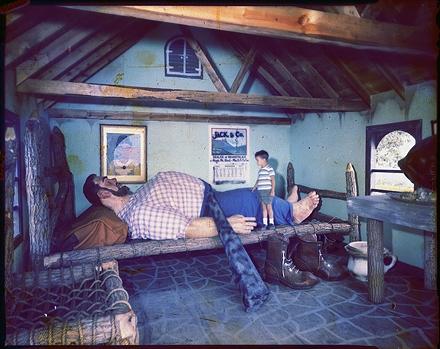In a new article about the Morton photographs from the Fall 2007 issue of UNC Friends of the Library’s Windows Magazine, entitled “Capturing Seven Decades of Life in North Carolina,” author Ginger Travis compares processing the Morton collection to “wrestling a bear.” I find this particularly funny because for the past few days I have been sorting through images of—you guessed it—BEARS!
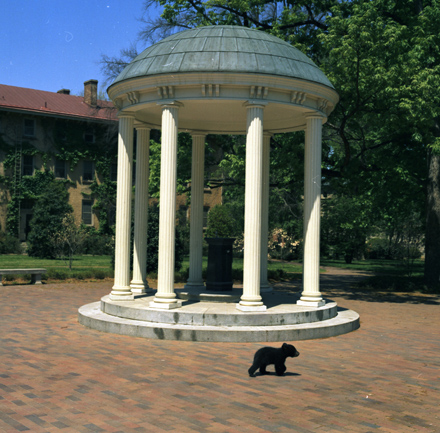 One set of negatives caught my attention early on—a series featuring an adorable black bear cub up to hijinks at various North Carolina landmarks (Biltmore, the State Capitol, the NC Botanical Gardens, Orton Plantation, etc.). Since these film rolls were cut up and scattered throughout the collection, with no identification, I was a bit mystified as to their context. Did Hugh Morton just toss a cub in the car and drive around the state so he could take pictures of it? If so, um. . . why?
One set of negatives caught my attention early on—a series featuring an adorable black bear cub up to hijinks at various North Carolina landmarks (Biltmore, the State Capitol, the NC Botanical Gardens, Orton Plantation, etc.). Since these film rolls were cut up and scattered throughout the collection, with no identification, I was a bit mystified as to their context. Did Hugh Morton just toss a cub in the car and drive around the state so he could take pictures of it? If so, um. . . why?
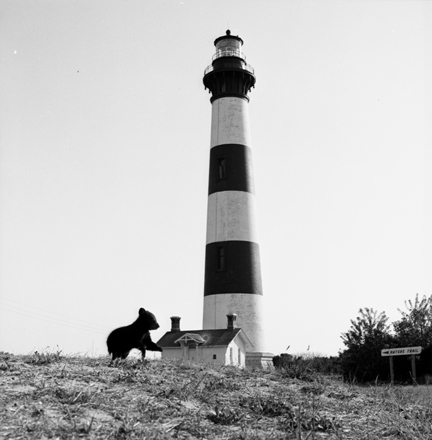 Then, the other day, I came across some of the bear cub negatives in an envelope labeled “Negatives–Zoo Trip with Little Bear–4-72,” in Morton’s hand. So, I’m guessing that Grandfather Mountain gave this bear cub to the North Carolina Zoo in April 1972, and these photos were taken on the (somewhat circuitous) trip to deposit him/her there. Can anyone confirm or deny that? Were the images used in some sort of promotional campaign?
Then, the other day, I came across some of the bear cub negatives in an envelope labeled “Negatives–Zoo Trip with Little Bear–4-72,” in Morton’s hand. So, I’m guessing that Grandfather Mountain gave this bear cub to the North Carolina Zoo in April 1972, and these photos were taken on the (somewhat circuitous) trip to deposit him/her there. Can anyone confirm or deny that? Were the images used in some sort of promotional campaign?

Category: Landmarks & Attractions
NC's "Immortal Showboat"
 In honor of the recently-opened exhibit, “Showboat”: The USS North Carolina (BB 55), at the North Carolina Museum of History, and since I just happened to be “passing” through this particular batch of negatives, I decided to highlight a few of my favorite Morton images related to the USS North Carolina.
In honor of the recently-opened exhibit, “Showboat”: The USS North Carolina (BB 55), at the North Carolina Museum of History, and since I just happened to be “passing” through this particular batch of negatives, I decided to highlight a few of my favorite Morton images related to the USS North Carolina.
Morton was enlisted in 1960 by his good friend and then-governor Luther Hodges to spearhead the ultimately successful campaign to preserve the battleship as a memorial to World War II veterans. The article “Saving Our Ship” on the USS North Carolina Memorial Web site provides background on the campaign and Morton’s leadership, noting in particular that “Morton’s drive to control the administrative costs of undertaking such a large campaign led to savings such as using his young son on campaign posters rather than paying for a model.” The image below must be a mock-up of one of those posters. [The boy in the image below is not one of Morton’s sons, but there are images in the collection showing Jim Morton holding a model of the USS NC that were possibly used on campaign posters.]
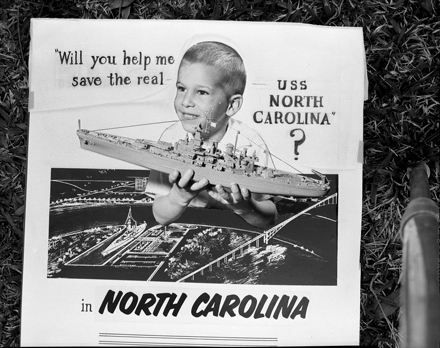
This last image depicts John Weaver working on two busts for the USS NC Museum (likenesses of FDR, Chester Nimitz, MacArthur, and Truman were made—not sure which two these are). [Correction: This is not John Weaver, but a Linville artist named Coffey, and these heads were not created for the USS NC. Just goes to show that an archivist can’t always trust the contextual information that comes with a document! Thanks to Julia Morton for clarifying.]
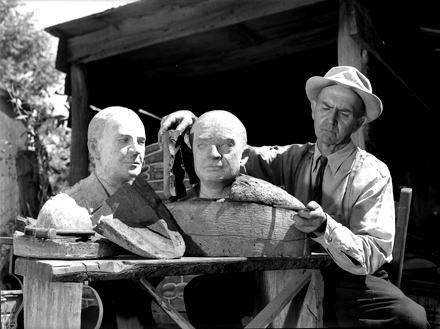
One last note: as I was just proofreading the contents of this post, I happened to notice today’s date: December 6. Tomorrow is the 66th anniversary of the attack on Pearl Harbor. Crazy coincidence strikes again on “A View to Hugh!”
A "giant" of NC tourism
Hugh Morton’s energetic promotion of travel and tourism in the Southern Appalachians is well known. This High Country Press article provides Spencer Robbins’ first-hand perspective on Morton’s tourism work, which included helping found both the Southern Highlands Attractions Association and the High Country Host. (Please note: the Goodman article reflects personal perceptions of events, and contains at least one inaccuracy when it states that Morton considered a run for governor in the mid-1980s; it was in 1971 that Morton announced his candidacy for the 1972 election, but he dropped out before the primary.)
Morton’s boosterism is definitely reflected in the images he produced. In addition to the hundreds (thousands?) of shots in the collection taken of, on, or around Grandfather Mountain, there are numerous photos of other attractions including outdoor dramas, lighthouses and other coastal landmarks, the Barter Theatre in Virginia, Georgia’s Rock City, The Blowing Rock, Tweetsie Railroad, and the wonderful Land of Oz on Beech Mountain. (Some of these will be featured in a later blog posts, so stay tuned!)
But here’s one we just can’t figure out. This splotchy negative appears to show a re-creation of the giant’s house from the Jack and the Beanstalk story, shown with a real-life boy to provide perspective. The calendar on the wall reads, “Jack & Co. We Grow ‘Em Big! Dealer in Beanstalks at Magic Mt. Blvd. Pho.: Fe Fi Fo Fum.” The date on the calendar (oddly) is “Augustus 1063,” a month which apparently had 33 days. I know the J & B tale is old, but that old?
Part of my fascination with this image is that it seems vaguely familiar, as if I might have visited this place as a kid. Help me out—do you know why, where, when, or of whom this picture was taken?

